 [Updated 1/12/20 with thoughts on video compression using the Mac Pro and iMac Pro.]
[Updated 1/12/20 with thoughts on video compression using the Mac Pro and iMac Pro.]
Last week, I took a first look at video compression speeds in the new macOS Catalina. In that article, I only had time to run a single series of tests with Apple Compressor.
This week, I ran more tests with Compressor and added Adobe Media Encoder.
First, though, I want to report that a bug in Apple Compressor that prevented it from compressing ProRes 4444 files into 10-bit HEVC in Mojave seems to be fixed in Catalina. While Compressor is still almost three times slower than Adobe Media Encoder in compressing the same file into 10-bit HEVC, at least now, Compressor is able to complete the job.
NOTE: Here’s an article comparing compression speeds of an i5 vs. i7 CPU.
TESTING PROTOCOL
I ran these these tests on the same computer (an iMac i5) using the same data files and same default YouTube 720p compression settings using the latest versions of Apple Compressor (4.4.6) and Adobe Media Encoder (14.0). Only Numbers and Spotify (because these tests take a LONG time) were running on my Mac during these tests.
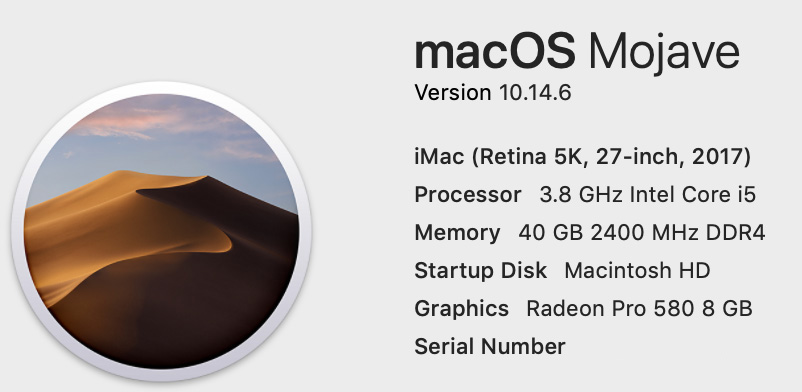
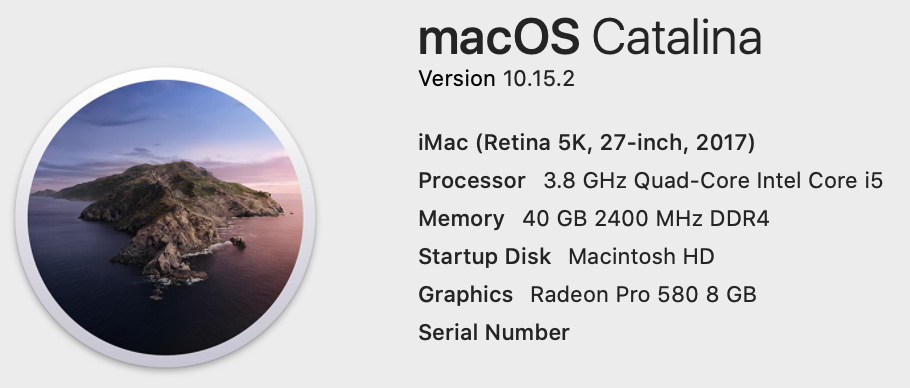
The Mojave test data are from earlier tests, but on the same system with the same files. The Catalina tests were all run on the same day for Adobe Media Encoder and Apple Compressor, except for HEVC on Compressor, which I ran a week ago.
The Compressor results for H.264 were so slow last week that, this week, I compressed each file three times and, because the results varied widely, averaged the results. What I learned is that when compression runs as a background process, compression times can vary a lot. For example, compressing a one hour program ranged from 11 to 21 minutes.
My media files consisted of programs edited in:
All files originated at 1280 x 720, except for the 1080p ProRes 422 HQ, which was scaled to 1280×720 for all tests. This is the same test data I’ve used for all my compression tests for the last five years.
APPLE COMPRESSOR RESULTS
The short answer is that, in general, macOS Catalina is slower for video compression than Mojave, but not by a lot. As you’ll see, this difference is most notable when compressing HEVC.
Here are the revised results for Apple Compressor, after running more tests for both Mojave and Catalina.
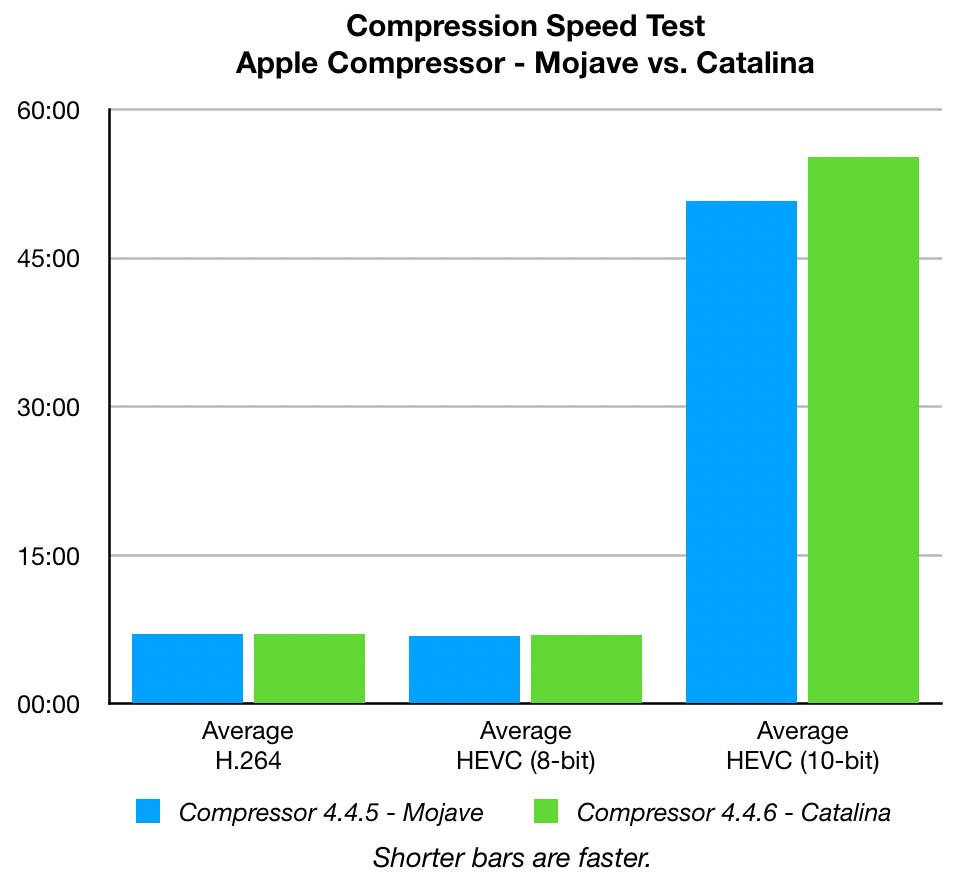
Essentially, for H.264 and HEVC, compression speeds between the two versions of the OS are the same, around 1%, as you can see from the table below. HEVC 10-bit speeds, though, slowed down.
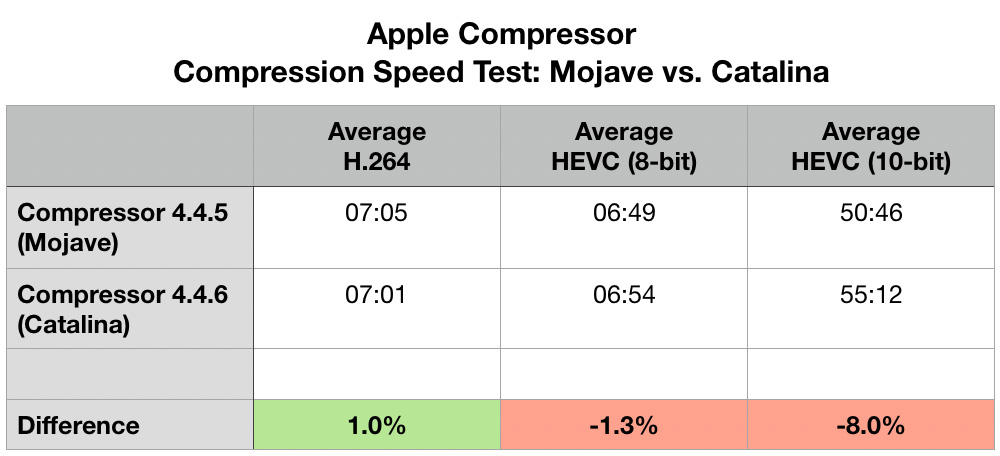
I also looked at file size to see if the new version was any more efficient. The short answer is: not really. With the exception of HEVC 8-bit, compressed file sizes were virtually identical.
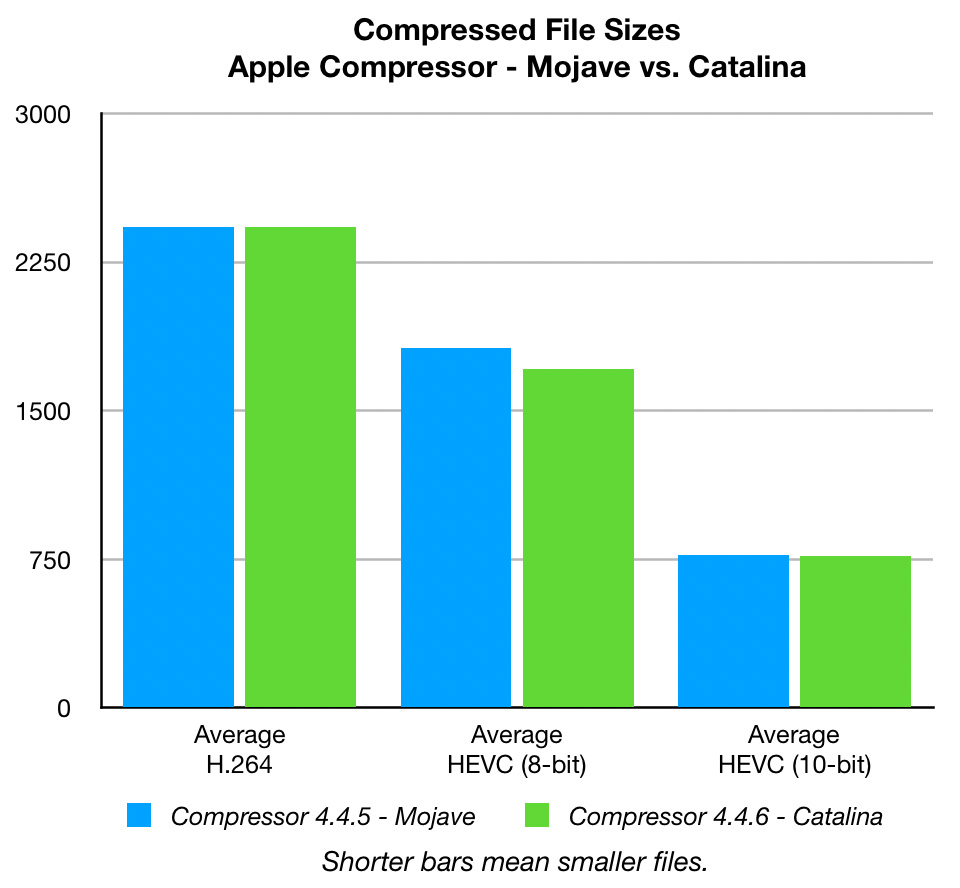
NOTE: Compressor, running in Mojave, was unable to compress a ProRes 4444 file into HEVC 10-bit. For this reason, file sizes are smaller than the other two tests.
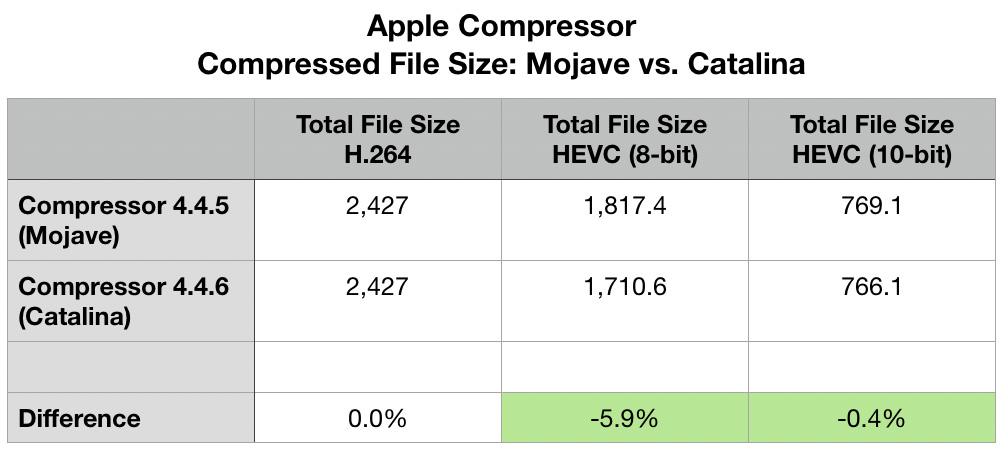
ADOBE MEDIA ENCODER RESULTS
Here are the results for Adobe Media Encoder for both Mojave and Catalina.
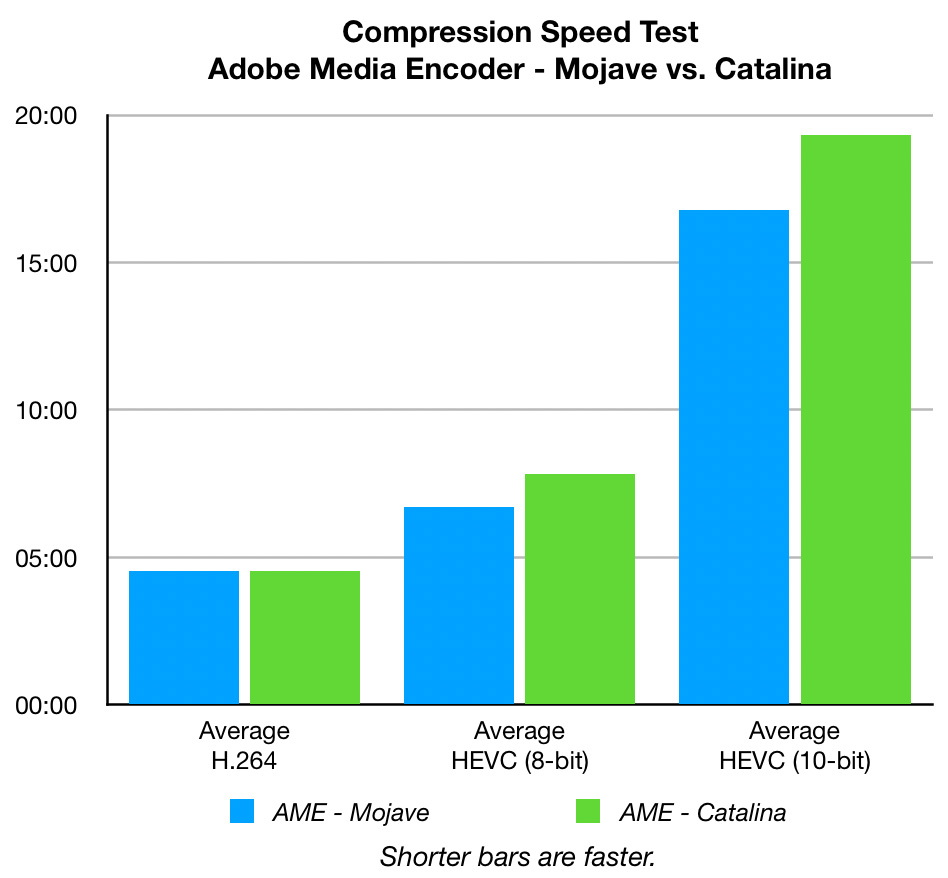
As we saw with Compressor, Catalina is not as fast as Mojave was. The numbers are below.
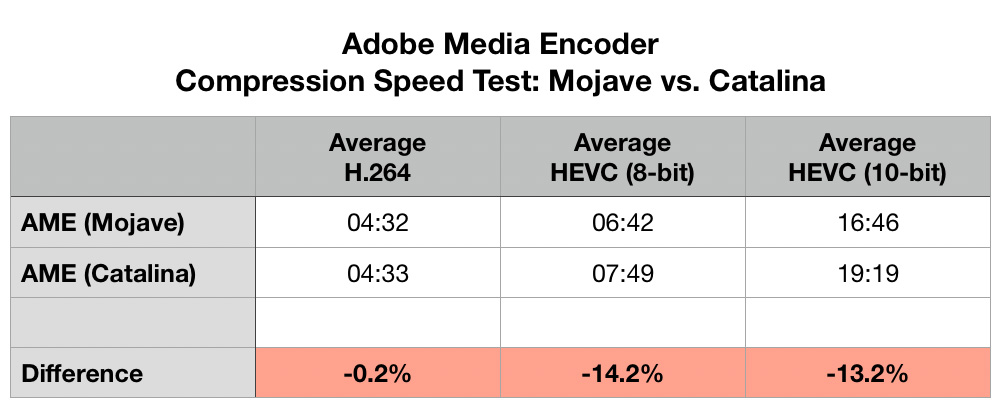
I also compared file sizes, however, because the default compression settings between AME and Compressor don’t match, we can’t compare compressed file sizes between the two applications.
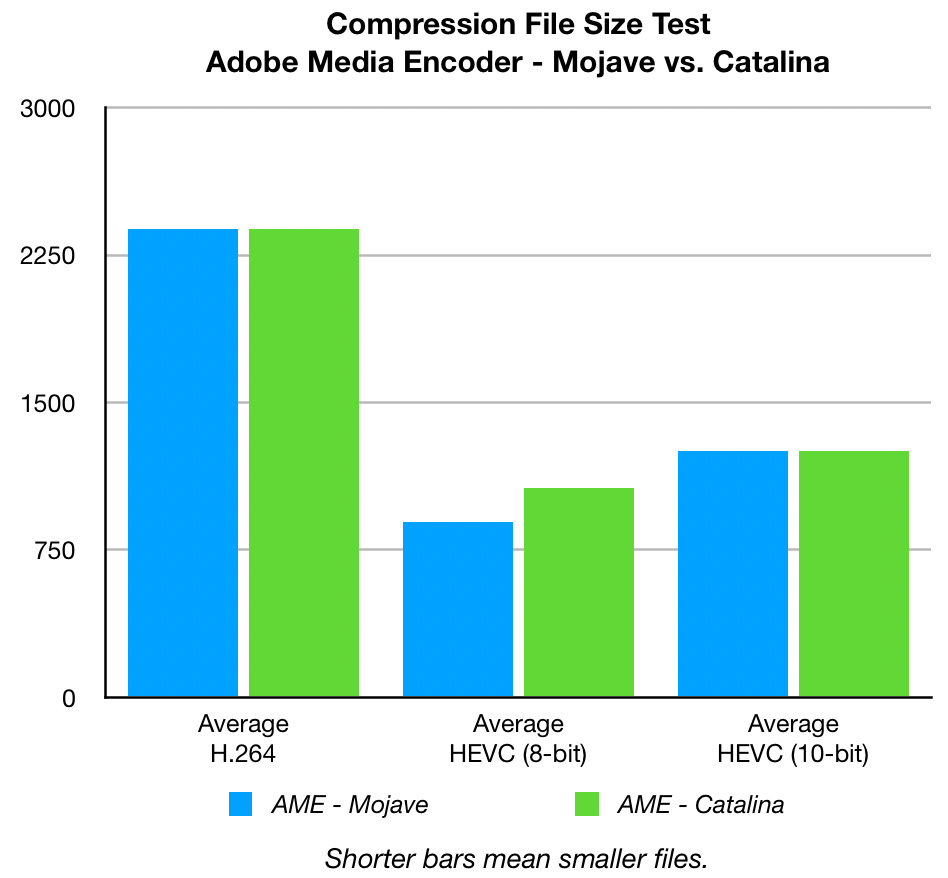
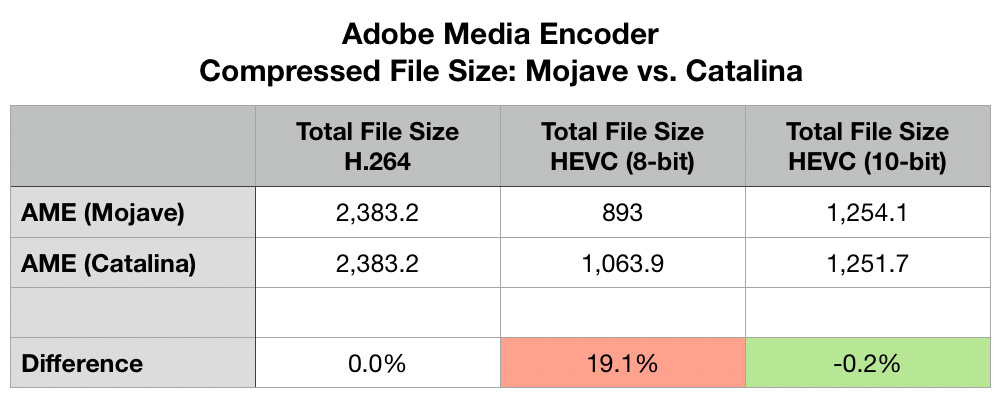
COMPARE APPLE COMPRESSOR TO ADOBE MEDIA ENCODER
Finally, I compared the compression speed of Apple Compressor to Adobe Media Encoder. Both were running on Catalina.
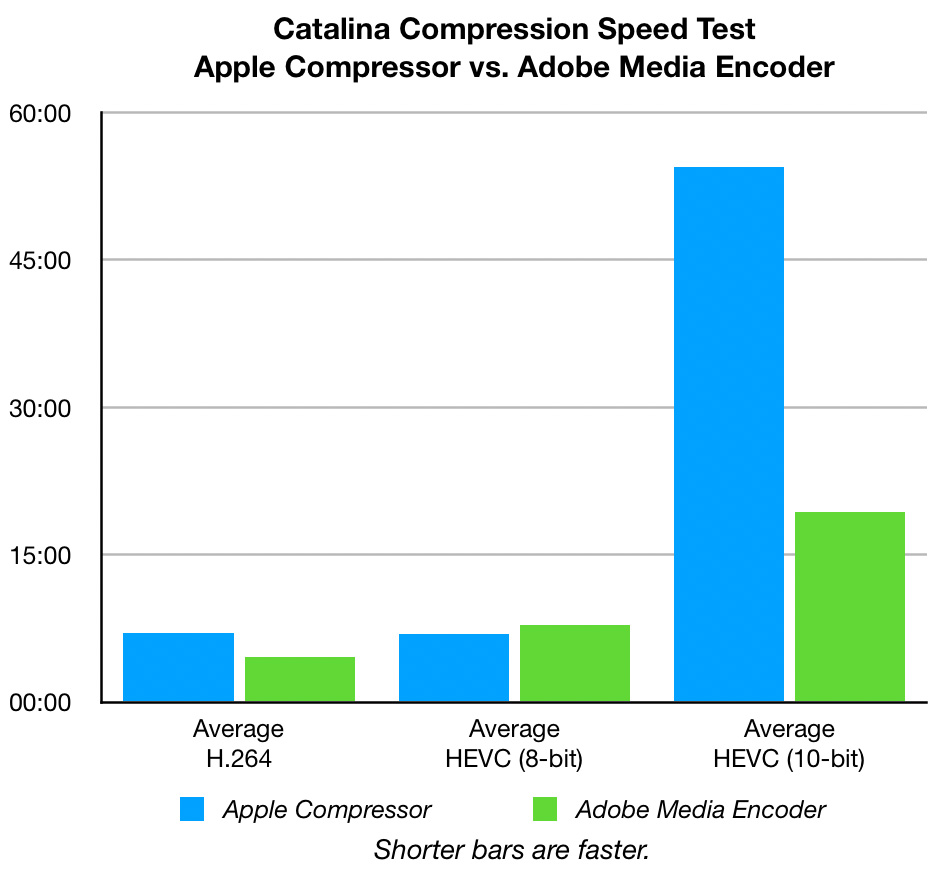
Adobe Media Encoder is significantly faster for H.264, slightly slower for HEVC 8-bit, and almost 3X faster for HEVC 10-bit. Here are the numbers.
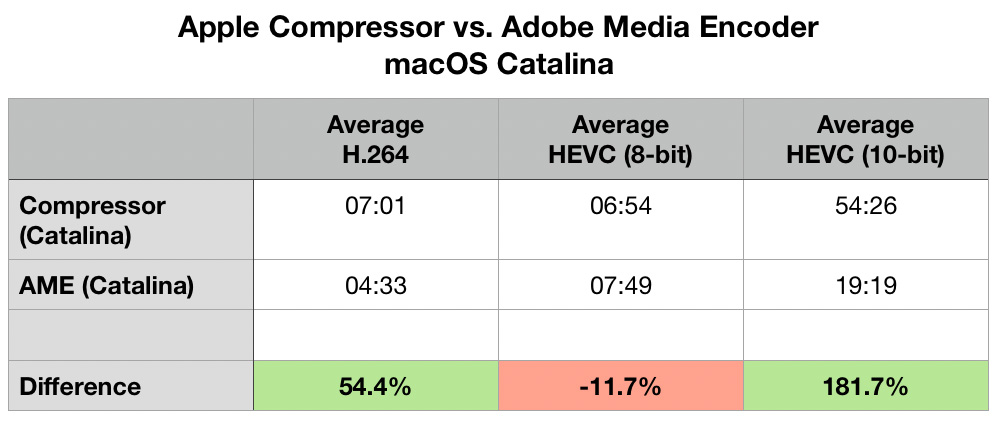
UPDATE – 1/12/20
These tests were run using an iMac with an i5 CPU, which supports hardware acceleration. However, the iMac Pro and Mac Pro use Intel CPUs that don’t support hardware-accelerated video compression.
What I learned was that both systems include a T-2 chip from Apple which, in addition to handling security, also handles video compression. In other words, the T-2 allows both systems to accelerate compression of H.264 and 8-bit HEVC. Because this is non-Intel hardware, compression performance will be different. For example, the performance slow-downs that I reported between Mojave and Catalina seem to be more pronounced on Intel CPUs than on the T-2.
SUMAMRY
While compression speeds will vary by CPU type and speed and, for Compressor, other applications you have running at the same time, we can see that Catalina did not bring any significant speed improvements to video compression.
As well, Adobe Media Encoder remains generally faster than Apple Compressor. Also, that Compressor is seriously slow when it comes to compressing HEVC 10-bit files.
2,000 Video Training Titles
Edit smarter with Larry Jordan. Available in our store.
Access over 2,000 on-demand video editing courses. Become a member of our Video Training Library today!
Subscribe to Larry's FREE weekly newsletter and
save 10%
on your first purchase.
11 Responses to Video Compression Speed Tests: Mojave vs. Catalina [u]
I appreciate your efforts in this time consuming test. Basically it tells me I am STILL in no hurry to “upgrade”.
Are they just doing this upgrade to hide the possibility they have a bunch of security problems?
Brian:
No, I’m not that cynical. The BIG! deal with Catalina is that is the first fully 64-bit OS. This is setting the stage for “that which is to come.”
Larry
That’s why I won’t upgrade to Catalina until I see way more 64bit support! Yes, Apple Compressor is slower than Media Encoder but it’s getting better!
Hi Larry, thanks for the article. Would it be possible to push an iMac Pro (standard version) with an external eGPU for video compressing to HEVC 10 with Compressor? Or using the T2 Chip in the iMac Pro together with another Mac having the same chip in a cluster … both Macs connected via usb-c? Would that bring substantially faster results? Best regards, Daniel (from Germany)
Daniel:
10-bit HEVC doesn’t work that way. Currently, there are no chips that I know of that support hardware-accelerated HEVC 10-bit compression. Also, my understanding of HEVC is that it needs to be compressed on the same chip, and can’t be delegated to a network.
So, for the moment, I would say, no.
Larry
Hi Larry, ok … understood. What can I do to get faster results … what about the eGPU? Or does the iMac Pro automatically uses the T2 chip … and that does not work either? Best regards, Daniel
Daniel:
It isn’t a question of “not working.” Different codecs using different parts of your computer. HEVC and H.264 are both CPU driven. ProRes heavily uses the GPU.
In general, video compression speed is based upon the CPU clock speed, first, then the number of cores. However, different codecs are different.
What I do, when I’m doing a LOT of video compression, is devote a single computer just for compression, with no other apps running. That provides the maximum amount of speed.
Larry
Can you talk at all about system usage during the encodes? What percentage of your CPU was being utilized, what portion of your GPU… what your settings were. Ram. Otherwise it’s hard to compare anything. I’ve noticed that compressor has been running very slow the last several versions because it’s no longer splitting files for encodes. Any codec.
Jonathan:
These questions – though good – are almost impossible to answer. However, H.264 files can not be split for encode. The GOP format prohibits it. What Compressor did, when using multiple cores, is encode different H.264 movies on different cores. Apple and I have chatted about this over the years, and the format, they tell me, doesn’t support stitching. This is why hardware acceleration is a better option for H.264 than multi-threading.
Because Compressor is a background app, we can’t specify how many system resources can be devoted to it. CPU usage, et al, is dependent upon everything else running on your system, which varies by user.
Finally, H.264 is not GPU accelerated.
Larry
Just got the late 2019 Macbook Pro and 4K 10-bit HEVC encoding is still painfully slow with compressor. It seems exporting a prores file and then running it through media encoder or an FFmpeg GUI is the way to go for now…
Jefbak:
Thanks for this report. The last several versions of Compressor take longer than normal to compress anything – and, in several cases, I’ve had 10bit HEVC compression totally fail. I like Compressor for its interface. But, when it comes to performance, it is below average.
Larry